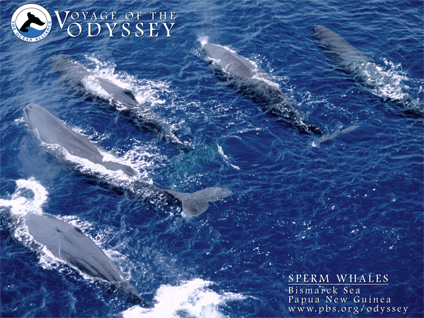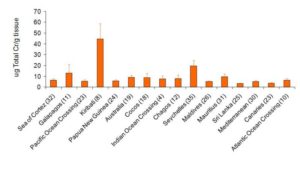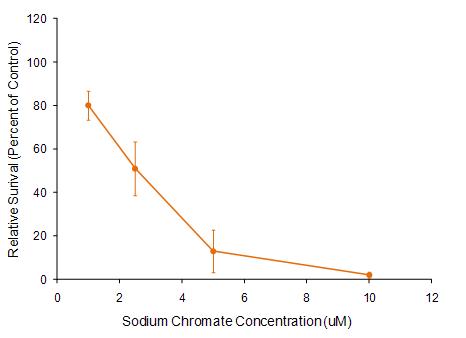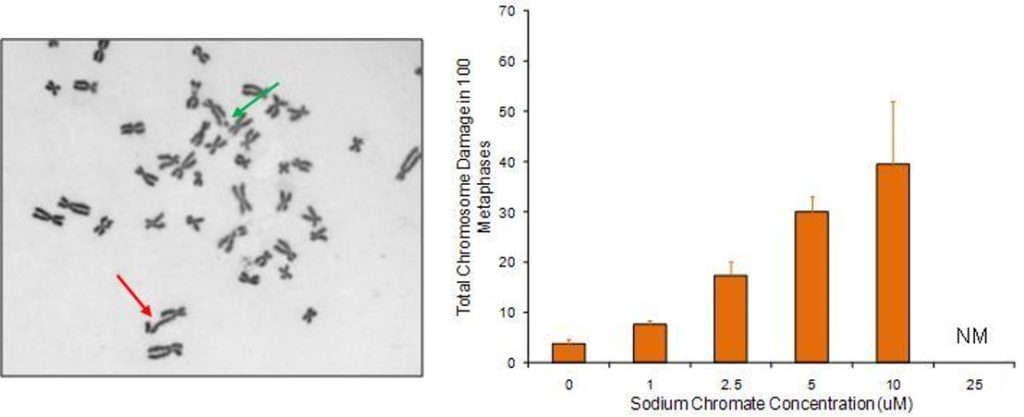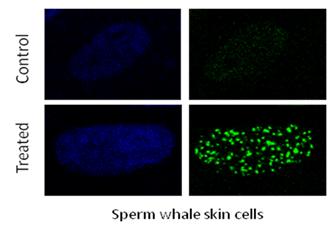What are we studying? | Why are we studying? | What are we finding? | What does it mean? | Where can I read more?
What are we studying?
We study sperm whales (Physeter macrocephalus) with our ‘One’ environmental health approach to gain an overview of global health investigating the health of humans, wildlife, and ecosystem health. Sperm whales live in all of the world’s oceans and can provide insight into global health as a wildlife species. They are large, and long-lived species that spends their entire life in the ocean where they may be exposed to environmental contaminants. Thus, we use sperm whales as a model species to understand the threat of metal pollution to them, to monitor the health of the oceans, and to understand human health. To accomplish this we employed several methods: 1) We collect whale tissue samples to measure metal levels including chromium. 2) We establish primary cell lines to measure chromium induced cell death and genetic changes and compare those outcomes to the same endpoints in human and other wildlife species cell lines. 3) We measure DNA and chromosome damage in fresh whale samples to determine if damage occurs in the individual and to monitor the population.
Why are we studying it?
Sperm whales are an endangered species. They are top predators in the marine food chain feeding primarily on squid and fish, much as humans are the top predator in their food chain. Sperm whales inhabit all oceans and they have a long life span. Thus, they are an ideal sentinel for studying the threat of marine pollution. Sperm whales also dive to great depths (over a mile deep) and can stay underwater for hours. Thus, they must have evolved novel adaptations to protect them from the environment. These adaptations may shed light on new way to approach human disease. We seek to identify the risk of environmental contaminant to the sperm whale populations and determine if right whales can serve as indicators of the threat of environmental contaminants to human health. We are also investigating novel adaptations in the whales.
Sperm whales are also a key species in the Gulf of Mexico. On April 20, 2010, the Deepwater Horizon oil rig exploded resulting in an uncontrolled release of crude oil into the ocean. By the time the well was capped and the oil flow stopped, the disaster had become the largest environmental oil crisis in U.S. history and the second largest in world history. Superimposed on the massive oil release, was the use of chemical dispersants that were sprayed on top of the oil and injected into the Gulf waters in unprecedented quantities. The toxicity of these dispersants is unknown, and it is uncertain how mixing them with oil might alter the toxicity of the oil. This crisis provides a unique and critical opportunity to understand the impact of ocean pollution on marine life. The data collected and the lessons learned will serve to inform us about the decisions made and the actions taken in the Gulf of Mexico, which will then, in turn, serve to inform us how to move forward in improving conditions in the Gulf of Mexico as well as inform us better on how to protect other important marine environments from this sort of disaster.
What are we finding?
Metal Levels
We have analyzed sperm whale skin samples, collected from free ranging animals over the years of 1999-2005. We measured the levels of several essential and non-essential elements (total of 22: aluminum (Al), arsenic (As), barium (Ba), beryllium (Be), boron (B), cadmium (Cd), chromium (Cr), copper (Co), iron (Fe), gold (Au), lead (Pb), mercury (Hg), magnesium (Mn), molybdenum (Mo), nickel (Ni), potassium (K), sodium (Na), silver (Ag), strontium (Sr), sulfur (S), titanium (Ti) and zinc (Zn) The analysis showed that various environmental contaminants were present in sperm whale skin tissue. Interestingly, we found levels of the heavy metal chromium, a well-known human carcinogen, in relatively high levels in sperm whale skin tissue. The graph below shows chromium levels in sperm whale skin tissue.
In the Gulf of Mexico sperm whales, we found high levels of chromium and nickel in sperm whale biopsies collected in the months following the oil spill; significantly higher than levels collected from other areas of the world.
Cytotoxicity
We investigated the cytotoxic effects of hexavalent chromium, a well know human carcinogen in sperm whale skin cells. Chromium (VI) caused cell death in sperm whale skin cells. We also found that chemical dispersants can cause cell death and damage chromosomes in sperm whale cells. The graph below shows soluble chromium (VI) is cytotoxic to sperm whale skin cells.
Chromosomal Instability
Chromosomal instability is a hallmark of cancer, and refers to abnormal alterations in chromosomes. These alterations can be in form of changes in the number of chromosomes (due to loss or gains of chromosomes) and/or aberrations in the structures of the chromosomes.
To study chromosomal aberrations we analyze metaphases from sperm whale treated cells. The most common chromosomal aberrations are chromatid lesions (breaks in one arm of the chromosome, where the width of the break is wider that the width of the chromatid) and gaps (breaks in one arm of the chromosome, where the width of the break is narrower that the width of the chromatid), and isochromatid lesions and gaps (breaks in both arms of the chromosomes). The figure below shows examples of damaged chromosomes [chromatid lesions (red arrow) and chromatid gap (green arrow)] in sperm whale cells (100X microscope magnification). The graph below shows that soluble chromium (VI) induces chromosome damage in sperm whale skin cells.
DNA Repair
All cells have mechanisms to repair DNA damage. These cellular mechanisms can be specific to the different types of DNA damage. DNA double strand breaks is one type of DNA damage that have been observed to be repaired. We perform two different assays to investigate this type of DNA damage. The figure below shows the first assay called the Comet assay because it looks like a comet in the night sky. DNA has a negative charge on it. Thus, in this assay, broken DNA pieces will move towards a positive charge faster than bigger pieces simply because they are smaller. The broken DNA, thus generates a ‘tail’, which will then looks like a comet. The figure below shows a sperm whale cell nuclei with no DNA double strand breaks that looks like a moon and a sperm whale cell nucleus with DNA double strand breaks that looks like a comet.
The other assay we use is an H2A.X immunofluorescence assay. In this assay, DNA double strand breaks are detected indirectly by analyzing a protein that is known signal within a cell that breaks are present and repair is needed. This protein is called H2A.X. Upon the formation of a DNA double strand break, several H2A.X proteins in the vicinity of the break are activated forming a focus of activated proteins. This focus can be visualized by immunofluorescence methods, where each focus (green dot) is known to represent one single DNA double strand break (the nucleus is stained in blue). The picture below shows sperm whale skin nuclei with and without DNA damage (shown as green dots).
What does it mean?
Our data support the suggestion that chromium (VI) and other metals pose a potential health risk to sperm whales who are exposed through either inhalation of chromium or other routes such as diet. Furthermore, because our data indicate that chromium (VI) damages chromosomes, chromium (VI) exposure may contribute to the development of cancer, developmental abnormalities and failure to reproduce. Our data also indicate that metals are an important concern in the Gulf of Mexico oil crisis and that dispersant exposure may pose a health risk for whales.
Where can I read more?
- Wise, Sr., J.P., Payne, R., Wise, S.S., LaCerte, C., Wise, J., Gianios, Jr., C., Thompson, W.D., Perkins, C., Zheng, T., Zhu, C., Benedict, L. and Kerr, I. A Global Assessment of Chromium Pollution using Sperm Whales (Physeter macrocephalus) as an Indicator Species. Chemosphere, 75: 1461–1467, 2009. PMID: 19324391.
- Wise, Sr., J.P., Wise, S.S., LaCerte, C., Wise, Jr., J.P., and Aboueissa, A. The Genotoxicity of Particulate and Soluble Chromate in Sperm Whale (Physeter macrocephalus) Skin Fibroblasts. Environmental and Molecular Mutagenesis, 52: 43-49, 2011. PMID: 20839228.
- Wise, Sr., J.P., Thompson, W.D., Wise, S.S., LaCerte, C., Wise, J., Gianios, Jr., C., Perkins, C., Zheng, T., Benedict, L., Mason, M., Payne, R. and Kerr, I. A Global Assessment of Gold, Titanium, Strontium and Barium Pollution using Sperm Whales (Physeter macrocephalus) as an Indicator Species. Journal of Ecosystem and Ecography, 1(1):1-9, 2011. doi:10.4172/2157-7625.1000101. PMID: Not Applicable
- Li Chen, T., LaCerte, C., Wise, S.S., Holmes, A., Martino, J., Wise, Jr., J.P., Thompson, W.D. and Wise, Sr., J.P. Comparative Cytotoxicity and Genotoxicity of Particulate and Soluble Hexavalent Chromium in Human and Sperm Whale (Physeter macrocephalus) Skin Cells. Comparative Biochemistry and Physiology – Part C: Toxicology & Pharmacology, 155: 143–150, 2012. PMID: 21466859. PMCID: PMC4084666.
- LaCerte, C. and Wise, Sr., J.P. The Potential Threat of Genotoxic Metals to Marine Mammal Health: A Case Study of Chromium Toxicity in Toothed and Baleen Whales in Aquatic Animals, Biology, Habitats, and Threats. Chapter 3, pp. 77-97, in Eder D.L. (ed.) Aquatic Animals: Biology, Habitats and Threats. Nova Science Publishers Inc., Hauppauge, NY. 2012.
- Wise, C.F., Wise, Jr., J.P., Wise, S.S. and Wise, Sr., J.P. Skin Biopsy Applications in Free Ranging Marine Mammals: A Case Study of Whale Skin Biopsies as a Valuable and Essential Tool for Studying Marine Mammal Toxicology and Conservation. Chapter 5, pp. 109-122 in Romero, A. and Keith, E.O. (eds.) New Approaches to the Study of Marine Mammals. InTech, Rijeka, Croatia. 2012.
- Savery, L.C., Evers, D., Wise, S.S., Falank, C., Wise, J., Gianios, Jr., C., Kerr, I., Payne, R. Thompson, W.D., Perkins, C., Zheng, T., Zhu, C., Benedict, L. and Wise, Sr., J.P. Global Mercury and Selenium Concentrations in Skin from Free-Ranging Sperm Whales (Physeter macrocephalus). Science of the Total Environment, 450–451: 59–71, 2013. PMID: 23467177.
- Pabuwal, V., Boswell, M., Pasquali, A., Wise, S.S., Kumar, S., Shen, Y., Garcia, T., LaCerte, C., Wise, Jr., J.P., Wise, Sr., J.P., Warren, W. and Walter, R.B. Transcriptomic Analysis of Cultured Whale Skin Cells Exposed to Hexavalent Chromium [Cr(VI)]. Aquatic Toxicology, 134-135: 74-81, 2013. PMID: 23584427. PMCID: PMC3739694.
- Savery, L.C., Wise, S.S., Falank, C., Wise, J., Gianios, Jr., C., Thompson, W.D., Perkins, C., Mason, M.D., Payne, R. Kerr, I. and Wise, Sr., J.P. A Global Assessment of Silver Pollution using Sperm Whales (Physeter macrocephalus) as an Indicator Species. Journal of Environmental and Analytical Toxicology, 3 (2):169-177, 2013. http://dx.doi.org/10.4172/2161-0525.1000169.
- Savery, L.C., Wise, S.S., Falank, C., Wise, J., Gianios, Jr., C., Thompson, W.D., Perkins, C., Zheng, T., Zhu, C., and Wise, Sr., J.P. Global Assessment of Oceanic Lead Pollution using Sperm Whales (Physeter macrocephalus) as an Indicator Species. Marine Pollution Bulletin, 79(1-2): 236–244, 2014. PMID: 24361115.
- Wise, Jr., J.P., Wise, J., Wise, C.F., Wise, S.S., Gianios, Jr., C., Xie, H., Thompson, W.D., Perkins, C. Falank, C. and Wise, Sr., J.P. Concentrations of the Genotoxic Metals, Chromium and Nickel, in Whales, Tarballs, Oil Slicks and Released Oil from the Gulf of Mexico in the Immediate Aftermath of the Deepwater Horizon Oil Crisis: Is Genotoxic Metal Exposure Part of the Deepwater Horizon Legacy? Environmental Science and Technology, 48(5): 2997–3006 2014. PMID: 24552566. PMCID: PMC3983321.
- Wise, C.F., Wise, J.T.F., Wise, S.S., Thompson, W.D., Wise, Jr., J.P. Wise, Sr., J.P. Chemical Dispersants used in the Gulf of Mexico Oil Crisis Are Cytotoxic and Genotoxic to Sperm Whale Skin Cells. Aquatic Toxicology, 152: 335–340, 2014. PMID: 24813266. PMCID: Not applicable.
- Savery, L.C., Wise, J.T.F., Wise, S.S., Falank, C., Gianios, Jr., C., Thompson, W.D., Perkins, C., Zheng, T., Zhu, C., and Wise, Sr., J.P. Global Assessment of Arsenic Pollution Using Sperm Whales (Physeter macrocephalus) as an Emerging Aquatic Model Organism. Comparative Biochemistry and Physiology – Part C: Toxicology & Pharmacology, 163: 55–63, 2014. PMID: 24473067.
- Savery, L.C., Li Chen, T., Wise, J.T.F., Wise, S.S., Gianios Jr., C., Buonagurio J., Perkins, C., Falank, C., Zheng, T., Zhu, C., and Wise, Sr., J.P. Global Assessment of Cadmium Concentrations in the Skin of Free-Ranging Sperm Whales (Physeter macrocephalus). Comparative Biochemistry and Physiology, Part C, 178: 136-144, 2015. PMID: 26456815.

